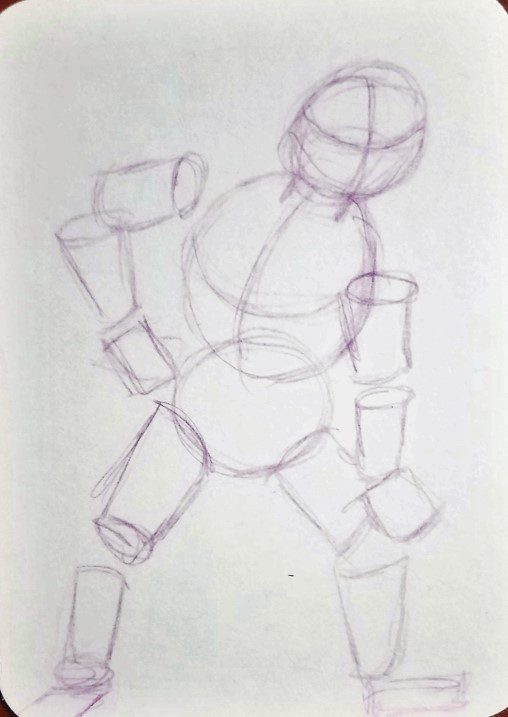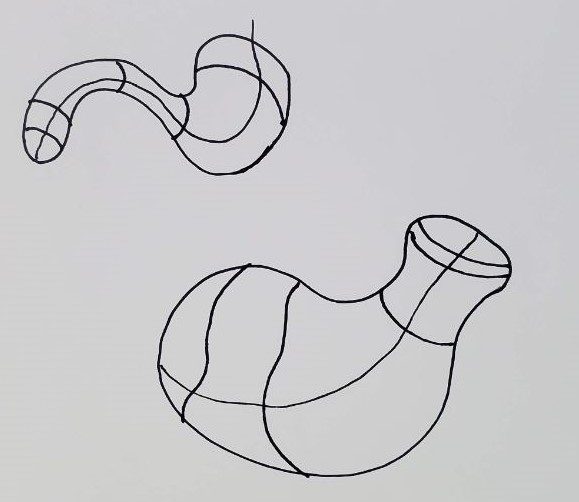What is Form In Art?
Form is one of the elements of art and is related to the physical shape of an object or how it takes up space. A form is measurable by length, width, and height. And it encloses volume.
Form in art could be the actual physical space something occupies, a statue for example.
Or it could be used to illustrate a three dimensional object on a two dimensional surface such as in a drawing. In this situation you’d be creating the illusion of depth.
In this article we’ll be focusing on this illusion of a third dimension through drawing techniques. As well as what to do with these skills and where to use them.
What Are the Types of Form in Art?
Form can be either geometric or organic. Geometric shapes have specific names and characteristics. These are sphere, cube, cylinder, pyramid, and cone, as well as some others.
Organic forms are free flowing, and are without specific characteristics or names. These would be the type of forms you find in nature.
Both geometric and organic forms can be found in both two dimensional and three dimensional works of art.
Geometric Forms in Art
As discussed earlier, geometric forms are generated using geometry and have specific names and characteristics. They are the 3D counterparts to 2D shapes. For example, a square becomes a cube or a sphere is a 3D circle.
We use these shapes and forms in our artwork all the time. They are great for constructing the guidelines for complex three dimensional drawings.
Cube
A cube is a three dimensional square or rectangle and can be drawn using one point or two point perspective.
You can also draw them freehand by following some simple rules that will help make things easier. This is the method I prefer because it’s less tedious and a more relaxed approach.
Cubes are found everywhere in day to day life. And learning to draw cubes will help you learn how to draw those objects as well. A Cell phone for example is really just a cube. So if you can draw a cube, you can draw a 3D cell phone. Pretty cool isn’t it?
You can read our full tutorial on this at How to Draw a 3D Cube for more information.
Cylinder
A cylinder is made up of two circles with a rectangle in the middle. There are many opportunities to use cylinders in your artwork.
One common technique is to use cylinders to make the under drawing of a human body. You can use them for the arms and legs, as well as the torso. We show you how to do this in our Using Shapes to Draw tutorial.

There are also tons of other objects in real life that can be built from a cylinder. Some examples would be a coffee cup, car tires, bottles, coins, spray cans, candles, and many others.
So as you can see, the element of art (form) is all around us, making it extremely important to learn and understand.
If you can master drawing a cylinder, you can master drawing many other objects in convincing 3D. For help, visit our How to Draw a Cylinder tutorial.
Sphere
A sphere is the 3D counterpart to the circle. It’s a symmetrical, round shape. Making it appear 3D is accomplished primarily with shading.
After you’ve learned how to shade a circle to create the illusion of 3D you can then apply those concepts to any object that’s a sphere so that you can make it appear round.
Take a look at our tutorial on How to Draw a Sphere to learn these shading techniques.
Cone
A cone is created by drawing a circle with a triangle on top. And again, to create a 3D illusion, you would use shading. Finding cones in everyday life is a bit more challenging than say , a cube or a cylinder. But they’re out there if you look hard enough.
An hour glass can be drawn using two cones. Other cone shaped objects are carrots, traffic cones, party hats, and witch hats.
So once again, learning how to properly draw and shade a cone will help you in your future drawings and works of art.
Organic Forms in Art
These shapes don’t follow any rules, nor do they have names. Organic forms, also called freeform shapes, are the ones you would find in nature.
They can be described as being free flowing, irregular, and having a natural look to them. Organic shapes are also quite often asymmetrical, instead of symmetrical such as geometric shapes are.

Using organic forms in your artwork can really be a lot of fun.
Final Thoughts on Element of Art Form
Although it may seem boring to learn the basic fundamentals of art, they will help take you further and do it more quickly than without learning them. Now that I’m older I really wish I would have learned them much sooner.
Art is a journey and you need to build off of wherever you are today. Identify your weaknesses, and fill in the gaps where needed. But above all else, have fun and enjoy the learning process.
If something doesn’t seem fun, find a way to make it fun. But keep pushing forward. And learn the elements of art – form, line, value, shape, color, space, and texture.
Get your FREE Elements of Art Guide


